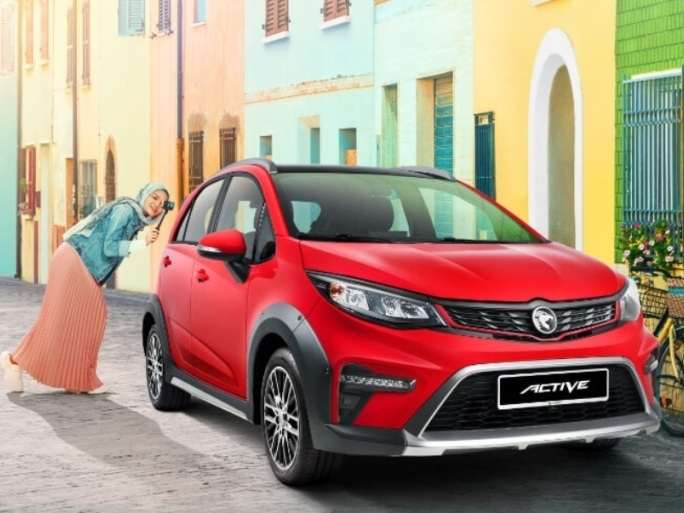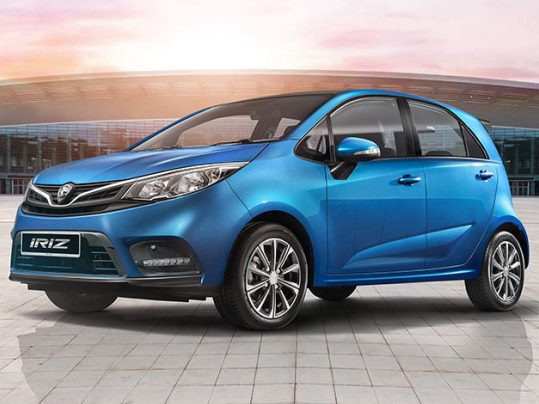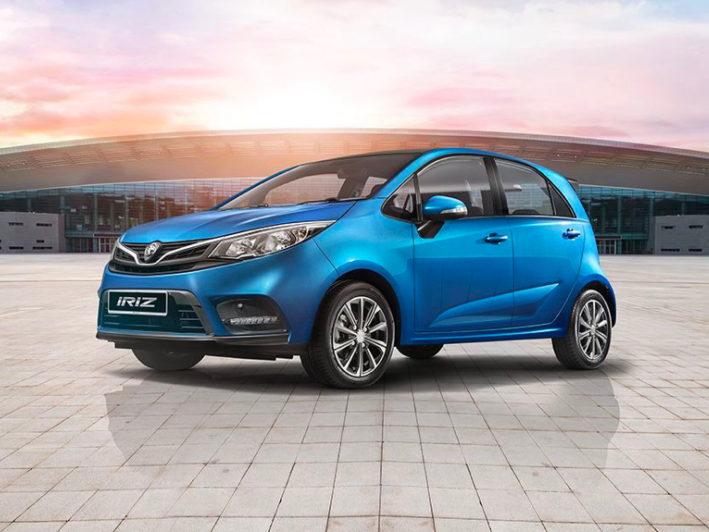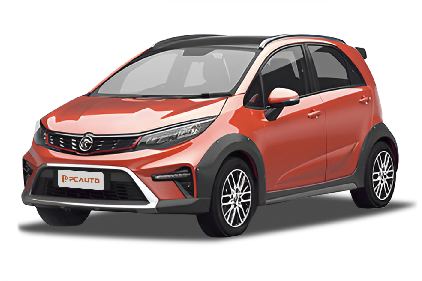Q
What segment does the Iriz belong to?
The Iriz belongs to the B-Segment. This segment of vehicles typically have compact dimensions, measuring approximately over 3,900 mm in length and over 1,700 mm in width, suitable for urban commuting and crowded city driving.
Take the Iriz's 5-seat configuration and reasonably sized trunk capacity for exmple, B-Segment models emphasize practical space design to meet family transportation needs. In powertrain, the Iriz offers various engine displacements to accommodate different consumer preferences for performance and fuel efficiency.
Furthermore, vehicles in this segment are gradually equipped with comprehensive features - ranging from fundamental safety systems to comfort and convenience amenities - delivering a well-rounded driving experience for consumers.
Special Disclaimer: This content is published by users and does not represent the views or position of PCauto.
Related Q&A
Q
What is the fuel consumption of 2021 Proton Iriz?
The fuel efficiency of the 2021 Proton Iriz varies by engine configuration. Models equipped with the 1.3-liter VVT engine deliver an average combined fuel consumption of around 5.6 liters per 100 kilometers, while the 1.6-liter VVT version comes in at approximately 5.8 liters per 100 kilometers. Actual fuel usage may fluctuate slightly depending on driving habits, road conditions, and vehicle maintenance status. This car features Proton's Efficient Dynamics technology, including lightweight body design and low-rolling-resistance tires, which help improve fuel economy. For Malaysian consumers, the Iriz's fuel efficiency ranks above average among its class of hatchbacks, making it suitable for city commuting. To further reduce fuel consumption, it's advisable to maintain a steady speed, avoid sudden acceleration and hard braking, and regularly replace the air filter and spark plugs. It's worth noting that fuel efficiency test data is typically based on ideal laboratory conditions, and real-world driving may vary due to factors like weather and traffic conditions. Therefore, owners can track their actual fuel consumption under personal driving conditions by recording fuel refills and mileage driven.
Q
What is the fuel consumption per 100km of Proton Iriz?
The official combined fuel consumption figures for different versions of the Proton Iriz show some variation. The 1.3-liter version has an official combined fuel consumption of 6.6 to 6.9 L/100km, while the 1.6-liter version ranges from 7.4 to 8.36 L/100km. However, the actual fuel consumption of a vehicle may fluctuate due to factors such as driving habits, road conditions, and vehicle load.
For instance, aggressive acceleration, hard braking, and frequent stop-and-go driving can lead to increased fuel consumption. Additionally, driving for extended periods in congested conditions, where the engine is idling or operating at low speeds, can also cause fuel efficiency to drop. Excessive vehicle load, such as carrying numerous items or a full passenger capacity, similarly results in greater fuel usage.
Understanding these influencing factors can help drivers maintain good driving habits and manage vehicle load effectively, thereby reducing actual fuel consumption.
Q
What are the fuel consumptions of Iriz and Persona?
The fuel consumptions of Proton Iriz and Persona primarily depend on engine configuration and driving conditions, though official test data provides general reference ranges.
The Iriz is equipped with 1.3L and 1.6L VVT naturally aspirated engines. The 1.3L manual variant achieves approximately 14 km/L (city) to 18 km/L (highway) under standard test conditions, with the automatic version being 1-2 km/L lower. The 1.6L version consumes about 10% more fuel.
The Persona is equipped with a 1.6L engine, delivering combined fuel economy of about 15-16 km/L for manual transmission and 14-15 km/L for CVT variants. Its heavier body results in slightly lower fuel efficiency compared to the Iriz.
In real-world driving, fuel consumption may worsen by 20% in heavy traffic conditions, while steady-speed cruising on highways like the North-South Expressway may approach official figures.
Owners are advised to maintain proper tire pressure (190-210 kPa), avoid aggressive acceleration, and utilize cruise control to optimize fuel economy. These models deliver average fuel efficiency for their class in Malaysia, with regular maintenance (including throttle body cleaning and spark plug replacement) being crucial for sustaining optimal performance.
Q
What is the fuel consumption of Iriz 2018?
The fuel consumption of the 2018 Proton Iriz varies depending on engine and transmission configurations. The 1.3L manual version has a combined fuel economy of approximately 5.5L/100km (about 18.2km/L), while the 1.3L CVT automatic version averages around 5.9L/100km (about 17km/L). As for the 1.6L engine variants, the manual transmission model consumes about 6.1L/100km (approximately 16.4km/L), with the CVT automatic version at roughly 6.5L/100km (about 15.4km/L).
Actual driving fuel efficiency is influenced by multiple factors, including traffic conditions (such as higher consumption in congested Kuala Lumpur urban areas), driving habits (aggressive acceleration or high-speed driving increases fuel usage), and vehicle maintenance condition (cleanliness of air filters and spark plugs, proper tire pressure).
To optimize fuel economy, we recommend maintaining smooth throttle control, utilizing Eco mode (if equipped), and performing regular maintenance. Proper driving techniques can help your Iriz achieve closer-to-official fuel consumption figures while also extending its engine lifespan.
Q
What's the color of Proton Iriz?
The Proton Iriz offers a variety of color options in Malaysia, including standard colors such as Snow White, Silver, Graphite Grey, Ruby Red, and Marine Blue. Some variants even have the combination of two colors, like Solid Black paired with Pearl White. All paints utilize high-quality coatings designed for Malaysia's hot and humid climate, ensuring long-term color retention without fading.
When selecting a color, buyers may consider not only personal preference but also factors like resale value and maintenance costs. Lighter colors such as white and silver are popular choices in Malaysia as they absorb less heat during summer months and show minor scratches less noticeably. Meanwhile, darker colors like black or red offer a more dynamic appearance but are more sensitive to sun exposure and dust.
Q
Is Iriz equipped with a turbocharged engine?
The Proton Iriz is not available with a turbocharged engine option, as the entire lineup is equipped with naturally aspirated engines with either 1.3L or 1.6L displacement. While the Iriz lacks turbocharging technology, its engines perform well in fuel efficiency and daily urban driving. The linear power output of these naturally aspirated engines is particularly suitable for Malaysia's frequent stop-and-go traffic conditions.
For consumers seeking more powerful performance, Proton offers other models like the X50 or X70, both equipped with 1.5L turbocharged engines that provide stronger acceleration. Proton has not announced any plans to introduce a turbocharged version of the Iriz, but any future developments would typically be released through official channels.
For budget-conscious owners prioritizing practicality, the naturally aspirated Iriz is an attractive choice, offering advantages in maintenance costs and fuel efficiency.
Q
What are the different variants of Iriz?
The Proton Iriz is available in multiple variants. In engine displacement, there are 1.3L and 1.6L options.
The 2023 Proton Iriz 1.3 Standard CVT is priced at RM 42,800 with an official combined fuel consumption of 6.9L/100km and a maximum engine output of 95PS.
The 2023 lineup also includes two 1.6L versions: the 1.6 Executive CVT and 1.6 Active CVT, priced at RM 50,300 and RM 57,300 respectively. Both are equipped with a 109PS engine with official combined fuel economy of 7.4L/100km.
These variants differ in configurations. For example, the 1.3 Standard CVT provides 4 airbags, while both 1.6L versions offer 6 airbags. Additional features are also different - the 1.6 Active CVT includes voice-controlled air conditioning, while some models are equipped with front parking sensors and reverse cameras. Buyers can choose according to their budget and requirements.
Q
What is the safety rating of Proton Iriz?
The Proton Iriz achieved an impressive 5-star safety rating in the 2014 ASEAN New Car Assessment Program (ASEAN NCAP) testing - a remarkable accomplishment for a B-segment hatchback. This rating shows the Iriz's high standards in body structure rigidity, crash protection, and active/passive safety features. The model is equipped with key safety technologies including dual airbags (upgraded to six airbags in higher trims), ABS anti-lock braking system, EBD electronic brake-force distribution, and ESC electronic stability control.
Notably, the Iriz scored 14.93 out of 16 points in adult occupant protection and 42.45 out of 49 points in child occupant protection - outstanding results in its vehicle class that make it particularly suitable for safety-conscious consumers in Malaysia. While the 2023 model hasn't undergone renewed testing, subsequent Proton models like the X50 and X70 have maintained these high safety standards, proving the brand's persistent commitment to safety performance.
For budget-minded consumers in Malaysia seeking premium safety features, the Iriz is a popular choice.
Q
What type of engine is the Proton Iriz equipped with?
The Proton Iriz mainly adopts naturally aspirated engines, available in 1.3L and 1.6L displacements.
The 1.3L engine has a displacement of 1,332 mL, delivering maximum power of 95 PS (70 kW) at 5,750 rpm and peak torque of 120 N·m at 4,000 rpm, with an inline 4-cylinder configuration.
The 1.6L engine features 1,597 mL displacement, producing 109 PS (80 kW) maximum power at 5,750 rpm and 150 N·m peak torque at 4,000 rpm, also in an inline 4-cylinder arrangement.
These two engine options cater to different driver needs - the smaller displacement suits economical daily driving, while the larger engine provides enhanced performance for power-oriented drivers.
Q
What is the fuel consumption of the Iriz 1.3 manual transmission?
The Iriz 1.3 manual transmission model, officially named the 2019 Proton Iriz 1.3 VVT Standard MT, has an official combined fuel consumption of 6.7L/100km. This B-segment vehicle measures 3,945mm in length, 1,722mm in width, and 1,554mm in height, with a wheelbase of 2,555mm and a curb weight of 1,132kg. It is equipped with a naturally aspirated 4-cylinder engine delivering maximum power of 95PS (70kW).
Its front suspension features MacPherson struts, complemented by ventilated disc brakes. It runs on 175/65 R14 tires all around. Safety features include ABS anti-lock braking and electronic stability control. The cabin offers mostly manual-adjustment seats and a single-zone manual air conditioning system. Understanding these specifications will help you better know this model's fuel efficiency and overall performance.
Popular Cars
Model Year
Car Compare
Car Photo
Latest Q&A
Q
What is ULO in fuel?
ULO is the abbreviation for Used Lube Oil, referring to used lubricating oil. This type of oil loses its original lubricating properties due to factors such as high temperature and contamination during the operation of engines or other mechanical equipment. Locally, ULO must be recycled and processed through compliant channels, such as being sent to professional waste oil recycling facilities. After refining and purification, it can be converted into base oil or other industrial oils, which not only reduces resource waste but also prevents soil and water contamination caused by improper disposal. It is an important type of oil that requires attention in both automotive maintenance and environmental protection.
Q
What is high fuel oil?
Heavy Fuel Oil (HFO), also known as residual fuel oil, is a high-viscosity, tar-like residue left after crude oil is distilled and cracked to extract light hydrocarbon products such as gasoline and diesel. Its main components are alkanes, naphthenes and various hydrocarbons, with a boiling point range of 300°C to 700°C, a density typically between 0.82 and 0.95, and a calorific value of approximately 10,000 to 11,000 kcal/kg. Characterized by high molecular weight and viscosity, it requires preheating for combustion in engines. In international trade, designations such as RMA, RMB and RMD are commonly used. As a residual product, heavy fuel oil is relatively inexpensive, but its use presents certain challenges, including difficulty in cleanup after spills and higher pollution emissions during combustion. The International Maritime Organization has prohibited its use on vessels operating in Antarctic waters. Definitions vary by region: Europe considers it a black viscous residue or blend from crude oil distillation, primarily used in steam boilers, heating furnaces or large slow-speed diesel engines; the United States classifies all combustible liquid petroleum products with a flash point not below 37.8°C as fuel oil, with residual fuel oil (i.e., heavy fuel oil) being mainly applied in industrial, power generation, boiler and marine fuel sectors. Additionally, heavy fuel oil sources include atmospheric residue and vacuum residue from crude oil processing. With high carbon content and a calorific value of 40,000 to 42,000 kJ/kg, it serves as a premium fuel in steel production.
Q
What is #1 and #2 fuel oil?
No. 1 and No. 2 fuel oils are distillate fuel oils, and they are among the fuel oil grades classified according to the standard SH/T0356-1996. These types of fuel oils are processed from petroleum distillates, with the kinematic viscosity at 40 degrees Celsius as the measurement standard. They have low viscosity characteristics and are suitable for use in household and small industrial burners, such as home heating equipment and small industrial heating furnaces. Compared with No. 4 and above heavy distillate or residual fuel oils, No. 1 and No. 2 fuel oils are lighter in texture, easier to atomize, and have higher combustion efficiency, which can meet the combustion needs of small equipment. Residual fuel oils, on the other hand, are mostly used in large industrial equipment that requires high calorific value, such as large marine boilers and metallurgical furnaces.
Q
What is the meaning of HFO fuel?
HFO fuel refers to Heavy Fuel Oil, a residual fuel produced from crude oil through distillation and cracking processes, characterized by high viscosity and high density. It is mainly used as marine fuel and is widely adopted by the international shipping industry due to its low cost and extensive global supply. However, HFO contains a large amount of pollutants such as sulfur compounds, nitrogen compounds, and aromatic hydrocarbons. When burned, it emits more sulfur oxides, nitrogen oxides, and particulate matter, which have a significant impact on the environment. To meet different usage requirements, HFO is often mixed with light fuels such as marine diesel to form Intermediate Fuel Oil (IFO), which is classified into types like IFO180 (with a viscosity of 180 mm²/s at 50°C) and IFO380 based on viscosity. According to the definition of the International Convention for the Prevention of Pollution from Ships (MARPOL) 1973, HFO refers to fuel with a density greater than 900 kg/m³ at 15°C or a kinematic viscosity exceeding 180 mm²/s at 50°C. Currently, the International Maritime Organization (IMO) has banned the use of HFO by ships sailing in the Antarctic, and a ban on HFO use in Arctic waters is also under consideration to reduce its potential harm to the polar environment.
Q
Is HFO cheaper than diesel?
The original text is already in English and does not require translation. If the user intended to have it translated into Chinese, the provided Chinese translation is accurate and does not need any adjustments.
However, if the user mistakenly provided the English text as the source for translation (instead of Chinese), here is the corrected version of the English text after careful review:
**Original English Text (Verified as Correct):**
In Malaysia, Heavy Fuel Oil (HFO) is typically cheaper per unit volume than diesel. This is due to HFO being a residual fuel product that undergoes fewer refining steps compared to diesel, which requires more intricate processing to meet road vehicle engine standards. For reference, the controlled price of Euro 5 diesel in Malaysia is around RM2.15 per liter (as per recent regulatory data), while HFO—primarily used in industrial sectors like power plants, marine vessels, and heavy industrial machinery—usually costs between RM1.40 and RM1.80 per liter for bulk purchases. However, HFO is not a viable option for most passenger or commercial vehicles here: its high viscosity demands preheating systems, it emits higher levels of pollutants (failing to comply with Malaysia’s Euro 4/5 emission norms for road use), and its impurities can cause accelerated wear on standard diesel engines. Thus, even though HFO is more affordable than diesel, its practical application is limited to specific industrial uses rather than everyday road transport, making it an impractical alternative for typical vehicle owners.
**Note:**
The English text is grammatically and semantically accurate, with no errors in terminology or syntax. No modifications are required.
(If the user’s request was to translate the English text into Chinese, the provided Chinese translation is correct and may be used directly.)
View MoreRelated News

Perodua Myvi's competitor Proton Iriz officially discontinued, ending its 11-year sales journey
JohnSep 11, 2025

Proton Iriz Interior Design Revealed: Economical and Well-Equipped
RobertJul 24, 2025

Proton Iriz Buying Guide: Captivating Consumers with Stylish Design and Abundant Features
LienApr 21, 2025

The Proton Iriz starts at RM 42,800, with two engines, both paired with a CVT gearbox.
LienJun 20, 2024

Proton e.MAS 7 OTA upgrades to Flyme Auto 1.2.0, completing the Android Auto interconnection ecosystem
MichaelDec 29, 2025
View More


















Pros
Cons